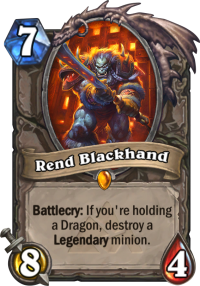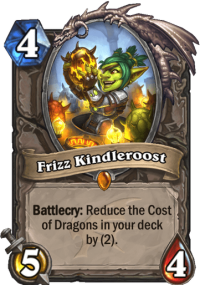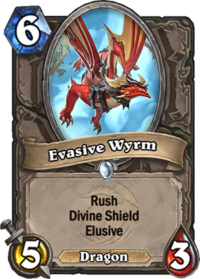So far, the Year of the Dragons was surprisingly short on, well, dragons. That’s no longer the case as the eponymous reptiles fill a decent portion of the upcoming set, with many powerful build-around options available to the players. This article will discuss the history of the dragon-holding keyword and previous decks built around their support cards, followed by a collection of theorycrafted Dragon decks roaring to go the moment the expansion hits!
Hold Up

In some ways, Team 5’s original solution to incorporating Dragons was extremely ingenious. Recognizing the fact that they are prohibitively expensive minions and will likely be stuck in your hand for a decent portion of the game, they decided to reward the player for this very fact by applying bonus effects on other cards. “If you’re holding a Dragon” stuck around across the years, but the power level of the cards with this text skyrocketed over time. In part, this is due to the increasing size of the card pool and also the realization of how important tempo is in a game governed by Hearthstone’s ruleset.
Crucially, the mana cost of relevant Dragon minions has also gone down as the game matured, making Dragon-based decks more viable in the metagame. Back in the BRM days, you basically only had Azure Drake available to you as a non-gigantic option (and, yes, Faerie Dragon, but come on now), with essentially every other fire-breathing fiend costing 8 or more across the board. This means that adding the requisite number of dragons to reliably satisfy the keyword requirements is no longer a crippling tempo sacrifice.
There’s also another reason for the increased power level in the available Dragon pool: for a very long time, cards in this tribe were exclusively Neutral, meaning they were comparatively weaker than they could have otherwise been. No class-specific Dragon was released until Blackrock Mountain (which was the third big content update in the game), and even then, we’ve only received two such cards, with Paladin’s Dragon Consort turning out to be an extreme disappointment. Priest’s Twilight Whelp, on the other hand, has become a staple going forward, even if the immediately following metagame was dominated by Patron Warrior (and its only semi-reliable counter, Handlock). The pattern continued into the future as well, with sparingly selected Dragon cards sprinkled across the sets.
Now, Descent of Dragons has 25 Dragons in the set and 15 cards that check for the Dragon holding condition.
That’s Quite the Package You’ve Got There

What made the Dragon package work (more or less) in the old day? As we’ve established above, it was the slate of neutral cards printed mostly around BRM. Blackwing Technician was a viable (but not omnipresent) little tempo bonus, but the star of the show at the time was Blackwing Corruptor. TGT’s Twilight Guardian also helped with mid-game stabilization for such decks, but in the end it was ONiK’s Netherspite Historian (and Book Wyrm, to some extent) which truly enabled such archetypes to generate enough resources to become viable late-game strategies.
Well, resource generation is not looking like a problem this time around, especially considering how little tempo you seem to have to sacrifice to enable Dragon-based decks in Descent of Dragons. Basically, we were granted with viable curve cards all across the spectrum with these neutrals, which could become a terrifying prospect going forward.
Starting on two mana, Dragon Breeder inexplicably has vanilla stats alongside a damn good value effect later in the game, but you can nevertheless just drop it on curve against aggressive opponents. Off the back of this, Scalerider looks even better than it normally does, a natural answer to 3/2 minions – again, immediately on curve – though it remains to be seen whether those cards will make up the bulk of aggressive early-game strategies over time. Though not an immediate tempo gain, Frizz Kindleroost also has tempo benefits which you can fairly quickly realize, though it does require a critical mass of dragons to warrant its inclusion. Big Ol' Whelp is yet another card which doesn’t sacrifice stats for a powerful effect (and a tribal tag), functioning as a perfectly reasonable way to contest the board in the mid-game, much like Azure Drake in the past.

Though not particularly flashy, Evasive Wyrm can be a very valuable part of these archetypes. Though it doesn’t guarantee a two-for-one, it will require a dedicated response, and if you squint just hard enough, you might make out the contours of Oasis Surger in a package which also serves to make up for early-game tempo deficiencies in some capacity.
Similarly, Twin Tyrant can serve as a closer against even midrange opposition in certain decks, especially after the upcoming rotation: even if it’s not quite a Primordial Drake and sorely lacks Taunt, it still packs a punch when played and has decent stats for the cost. At last, though certainly not the least, Dragonqueen Alexstrasza is a disgustingly strong option, albeit not one that can be added to every Dragon deck. Whether there’s enough redundancy (or reliable card draw) to make it work across the board remains to be seen – nevertheless, there’s no question that it’s an excellent minion to have at your disposal whenever the condition is active.
Though it makes less sense to look at class cards when analyzing these general “packages”, a special shoutout has to be given to Crazed Netherwing, Amber Watcher and Emerald Explorer as cards that so brutally crush the Vanilla Test it might as well be retired as an analysis tool for the next two years.
Descent of Dragons – Theorycraft Dragon Decks
Here’s a quick rundown of our oven-ready Dragon decks for the new expansion:
Dragon Ramp Druid
The basic concept of Druid’s new Dragon deck is straightforward: ramp up and play big dragons. However, digging into the available cards a bit more reveals an interesting idea about the potential win conditions. There aren’t actually that many strong ramp tools, even with Breath of Dreams – you do, however, have a ton of card draw to utilize. That is especially important if you want to make use of the Dream Portals generated by Ysera, Unleashed. As such, the featured build opts for a slightly lower curve with a lot of initiative tools, plus copious amounts of card draw (including a copy of Overflow, though Nourish is potentially a better alternative for slower matchups) to generate a consistent board presence until the free dragons fly in to finish off your opposition. With all the Battlecry effects in play, Barista Lynchen and Jepetto Joybuzz serve as interesting curveballs to throw in value-based matchups.
Aggro Dragon Hunter
Though there’s a lot of hype about a midrange-ish Dragon archetype, the relevant Hunter class cards are uniquely well-suited for an aggressive strategy, as long as you can cobble together enough tribal support in a low-curve deck to make them work. With Faerie Dragon, Nightmare Amalgam and Primordial Explorer, Stormhammer should be active often enough, and Dragon Breeder doubles as a curve card and a source of staying power if the game goes longer. Hoard Pillager seems like an extremely underrated aggro option, and with the two copies of Eaglehorn Bow added for redundancy, this build should be capable of non-stop weapon swinging, which is pretty much the wet dream of aggro players.
Pro tip: don’t tell the Control players: Scalerider can go face. Might be worth experimenting with that one as well.
Dragon Control Mage
An interesting part of the current Mage toolkit is that there are enough Discover effects going around to allow you to build a mostly minion-based deck without having to give up on the class’ juicy initiative tools. The featured build opts for all the juicy stuff coupled with spells that are compatible with Tortollan Pilgrim, including the (admittedly ultra-greedy) “double Luna” combo alongside the usual suspects.
Dragon Paladin
Slower Paladin archetypes basically went the way of the dodo ever since Hearthstone’s Control decks started working with resource generation rather than exhaustion. As it turns out, summoning an endless sea of Silver Hand Recruits over a long period of time isn’t quite enough when your opponents can reliably add at least half a dozen cards to their hand over the course of the match. With this development in mind, most Paladin decks inevitably had to go in a faster direction, and it’s quite possible that the smattering of Dragon support tools from previous sets has now reached the critical mass required to enable this kind of an archetype for the class. The featured build attempts a midrange strategy with the goal of finishing off the fight off the back of the tempo generated by overstatted minions before the cavalry arrives for the dedicated Control decks.
Dragon Control Priest
Since the Galakrond deck is inevitably going to be more proactive than a pure Dragon-based Control Priest build, we wanted to have some fun with this one and go down the ultimate greed route. If you miss the Deathrattle Priest decks from the Doom in the Tomb event, we’ve made a valiant attempt to recreate the experience for you. Results may vary!)
Dragon Control Shaman
Just like in the case of most decks above, the most promising part of the Dragon package in this set is the level of initiative they bring to the table. In the case of Shaman, this means there are actually enough Battlecry tools to work with even in the case of a slower deck. By the same token, the exclusion of Squallhunter will likely be seen as the most controversial decision with the featured deck – however, it has a very negative effect on the curve and it can’t be played alongside Earthquake later in the game. A different build without an emphasis on Battlecries would likely make great use of it – this is something a little different.
Dragon Handlock
It’s been a long time since we’ve seen a pure Handlock deck: the last time Warlock had a chance to play around with Mountain Giants in a non-meme fashion was back in the dark days of Genn and Baku, when Evenlock’s ability to drop one of those behemoths on turn 3 made it a fantastic option in the metagame, often capable of much more aggressive lines than their previous counterparts. Some of the fancier new class cards in Descent of Dragons gives us a good reason to revisit the archetype, with a few minor alterations to incorporate a decent-sized Dragon package.
Nether Breath is worth its weight in goal for slower decks, and Crazed Netherwing also makes it worth your while to add some other Dragons to the mix. Considering Twilight Drake was always a staple in the archetype – and that Zzeraku the Warped is also a Dragon – there’s just enough to work with here. For a deck which values hand size a lot, we also dropped in two copies of Cobalt Spellkin to the featured build: the slate of Warlock 1-cost spells is surprisingly flexible right now, with options like Plague of Flames, Spirit Bomb, Shriek and Soulfire providing initiative alongside admitted duds like Call of the Void and Corruption. (It can also fish out the quest for you, which is just a hilarious idea.) The featured build also includes Archivist Elysiana to ensure that you can keep up in a longer match despite all the extra draws.
Dragon Control Warrior
The launch of Descent of Dragons will be a sad day for Control Warrior players everywhere. The presence of Platebreaker as a tech option means that you need to have a more proactive strategy even with the slower archetypes of the class. Though we still value the “remove-things-until-Dr.Boom” strategy, a lower-than-usual curve coupled with the removal of a few staple board clear tools for additional board presence serves as a reasonable Dragon-focused update on the classic archetype.
Leave a Reply
You must be logged in to post a comment.















































































































I like the Warlock and Warrior decks.
Besides that, I have concerns about a lot of decks looking the same – if you want to play dragons, no matter which class, a lot of cards are pre-set (same goes for HL decks in a game where the pile of cards is 30).
Aaand where is Dragonmaw Poacher? Should be in every deck day 1. 😀
Based of a lot of the decks above and some of the other theory crafts, do you think it a safe bet to craft Crowd Roaster?
Thanks Yellorambo; all the decks looks very solid and well constructed. The “Dragon package” with Big Ol’whelp, Dragon Breeder, Cobalt Spellkin is a very good complement to old friends Scorcher, Crowd Roaster, Firetree Witch, etc.. Looks promising.
Thank you for the article, personnaly i think that dragon shaman didn’t get enough support to build a dragon deck, moreover hearth of vir’naal lose all of it’s potential in dragon deck. However i really like the warlock and warrior deck, they seems really consistent.
Great article! I do think any history of the “bonus effect if you’re holding a dragon” mechanic should mention Duskbreaker, though ^^